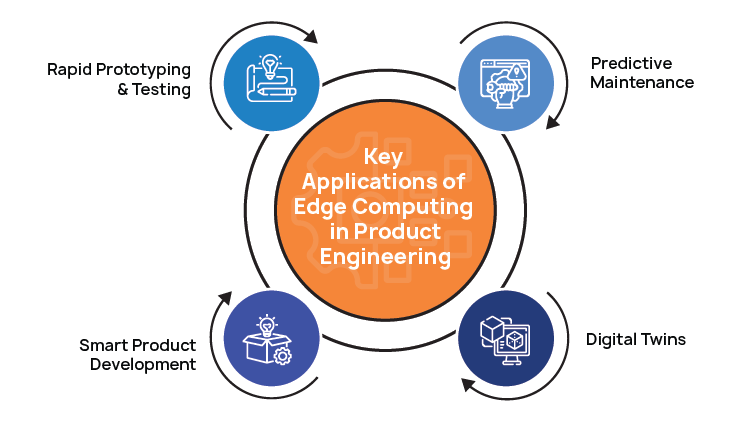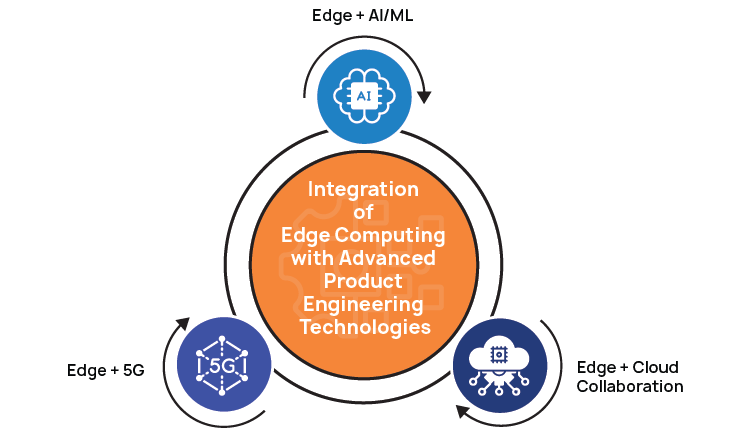

ACL Digital
5 Minutes read
Edge Computing in Digital Transformation Enabling Real-Time Product Engineering Insights
Digital transformation is reshaping product engineering, driven by the need for innovation, efficiency, and connectivity. Modern product engineering demands real-time data-driven decision-making to meet the complexity of today’s systems and user expectations. Edge computing has emerged as a transformative technology, enabling decentralized data processing at or near the data source. Edge computing bridges the gap between raw data generation and actionable intelligence by minimizing latency, reducing bandwidth dependencies, and ensuring rapid insights. Its ability to process data in real-time has made it indispensable in product engineering, where precision, speed, and adaptive capabilities are critical. As organizations strive to optimize processes and deliver smarter, more responsive products, the integration of edge computing is becoming a cornerstone of next-generation engineering solutions.
Challenges in Product Engineering Addressed by Edge Computing
Edge computing addresses several critical challenges faced in modern product engineering:
- Data Deluge in IoT-Driven Devices: IoT-enabled devices generate vast sensor data. Managing this influx in real time without overwhelming centralized systems is a challenge. Edge computing processes and filters data locally, ensuring only actionable insights are transmitted to the cloud.
- Latency and Bandwidth Constraints: Mission-critical applications, such as autonomous vehicles or industrial automation, require ultra-low latency. Edge computing eliminates the delays caused by data transmission to remote servers, enabling real-time decision-making while reducing dependency on high-bandwidth networks.
- Security and Compliance: With growing concerns over data privacy, especially in regulated industries, processing data locally at the edge minimizes exposure to security breaches. It also facilitates compliance by ensuring sensitive data remains within defined geographical or organizational boundaries.
- Scalability in Complex Ecosystems: As connected ecosystems grow in size and complexity, traditional centralized architectures struggle to scale efficiently. Edge computing offers adaptive solutions that distribute computational loads, making it easier to scale connected devices and ensure consistent performance across the ecosystem.
Key Applications of Edge Computing in Product Engineering
Edge computing is revolutionizing product engineering by enabling real-time decision-making and advanced capabilities. Some of its impactful applications include:
- Predictive Maintenance: In manufacturing and consumer electronics, edge computing powers real-time monitoring systems that predict equipment failures before they occur. By analyzing sensor data locally, edge-enabled systems detect anomalies, estimate remaining equipment life, and trigger maintenance workflows. This minimizes downtime, reduces operational costs, and enhances product reliability.
- Digital Twins: Edge computing facilitates real-time synchronization between virtual models (digital twins) and their physical counterparts. By processing data at the edge, digital twins can continuously update with live input, enabling real-time simulations and performance analysis. This capability is invaluable in testing complex systems, optimizing designs, and improving operational efficiency.
- Smart Product Development: Autonomous devices such as industrial robots, smart home appliances, and connected vehicles rely heavily on edge computing to process data locally. By integrating AI/ML models at the edge, these products can make intelligent decisions on-site, adapt to changing conditions, and deliver enhanced functionality. This decentralization reduces reliance on cloud connectivity and improves system responsiveness.
- Rapid Prototyping and Testing: Edge computing accelerates prototyping by providing real-time insights during design iterations. Engineers can monitor performance, analyze failures, and test product behaviors in real-world conditions without the delays of centralized data processing. This iterative feedback loop shortens development cycles and ensures the final product meets performance expectations.

Integration of Edge Computing with Advanced Product Engineering Technologies
Edge computing integrates seamlessly with cutting-edge technologies, reshaping how products are developed and deployed:
- Edge + AI/ML: Edge computing empowers the deployment of AI and machine learning models directly on edge devices, enabling intelligent decision-making closer to the data source. This reduces dependency on centralized systems, enhances response times, and supports real-time analytics. For example, edge devices equipped with AI models can autonomously identify defects in manufacturing processes or optimize energy usage in smart appliances, ensuring improved efficiency and functionality.
- Edge + 5G: The convergence of edge computing with 5G technology provides ultra-low latency communication networks critical for next-generation products. This integration supports advanced use cases such as autonomous vehicles, industrial robotics, and augmented reality (AR) systems, where instantaneous data exchange is vital. The high-speed connectivity of 5G combined with edge computing ensures faster data transfer and localized processing, facilitating real-time control and operational precision.
- Edge + Cloud Collaboration: Edge computing complements cloud systems by enabling hybrid architectures that optimize data storage, analytics, and cost efficiency. Time-sensitive and mission-critical tasks are processed locally at the edge, while the cloud handles large-scale data aggregation and advanced analytics. This collaboration allows scalable solutions, efficient resource utilization, and enhanced system performance. For instance, in IoT ecosystems, edge nodes can manage immediate processing tasks while transferring non-critical data to the cloud for historical analysis and predictive modeling.

Technical Benefits of Edge Computing in Product Engineering
Edge computing offers several technical advantages that redefine engineering processes:
- Reduced Time-to-Market: Edge computing accelerates development cycles by providing real-time analytics during the design and testing phases. Engineers can gather and process critical performance data on-site, enabling faster issue identification and more efficient iteration. This rapid feedback mechanism shortens prototyping timelines, streamlines validation processes, and expedites deployment to market, offering a competitive edge in industries with tight production schedules.
- Enhanced Product Reliability: Continuous monitoring through edge devices ensures that real-time insights are available to detect anomalies, assess performance metrics, and predict potential failures. This level of granularity allows for adaptive improvements throughout the product lifecycle. For instance, in industrial applications, edge systems can dynamically adjust equipment parameters to maintain optimal operating conditions, thereby increasing reliability and reducing downtime.
- Improved User Experience: Edge-enabled consumer products offer highly personalized and responsive interactions by processing user data locally. Real-time decision-making at the edge eliminates latency, allowing smart devices to deliver instantaneous responses and tailored functionality. Examples include voice-activated systems that process commands at the device level or wearable health devices providing immediate feedback, enhancing usability and customer satisfaction.
- Resource Optimization: Edge computing minimizes the strain on centralized computing infrastructure by distributing processing tasks closer to data sources. This decentralized approach reduces the need for extensive data transmission, optimizing bandwidth and energy consumption. Additionally, edge systems intelligently allocate computational resources, ensuring connected devices operate efficiently without overloading. This optimization in energy-sensitive applications, such as IoT devices, translates into extended battery life and reduced operational costs.
Case Studies: Edge Computing in Action for Product Engineering
Edge computing has revolutionized product engineering across diverse industries, offering technical advancements that address real-world challenges. Below are detailed case studies highlighting its impact:
- Deployment of Edge-Enabled Predictive Maintenance in a Global Manufacturing Firm: A leading global manufacturer faced frequent disruptions due to unplanned equipment downtime, reduced operational efficiency and increased maintenance costs. The company integrated IoT sensors and edge devices across their production lines by deploying edge-enabled predictive maintenance systems. The sensors continuously monitored key parameters, such as vibration, temperature, and pressure, while edge devices processed this data in real-time using AI/ML algorithms. By analyzing historical patterns and detecting anomalies locally, the system accurately predicted potential failures. The insights were immediately fed to on-site maintenance teams, enabling just-in-time interventions and reducing downtime by over 30%. Additionally, the edge architecture minimized data transmission to the cloud, lowering bandwidth usage and ensuring compliance with stringent data privacy regulations.
- Real-Time Digital Twin Implementation in Automotive Design: An automotive OEM leveraged edge computing to implement digital twin technology during vehicle prototyping. Each prototype vehicle had edge-enabled IoT modules that captured real-time telemetry data, including engine performance, suspension dynamics, and battery efficiency.
The edge system synchronized this data with the virtual twin model, enabling engineers to simulate real-world conditions and analyze vehicle behavior in real-time. The high computational power at the edge ensured that data-intensive simulations, such as crash testing and aerodynamics optimization, were processed locally without delays. This setup reduced the iteration cycle by 40%, allowing engineers to refine designs faster and address performance gaps before physical testing. The hybrid edge-cloud framework ensured that non-critical data was archived for further analysis while maintaining real-time performance. - Edge-Based Analytics for Optimizing Smart Home Appliance Performance: A smart home appliance manufacturer adopted edge computing to enhance the performance of its connected devices, including refrigerators, washing machines, and HVAC systems. The company enabled real-time data processing and decision-making capabilities by embedding edge devices into the appliances.
For example, in a smart refrigerator, edge-based AI models process sensor data related to temperature, humidity, and usage patterns locally. The appliance could autonomously adjust cooling settings, notify users of spoilage risks, and optimize energy consumption without constant connectivity to the cloud. This localized intelligence reduced latency, enhanced user satisfaction through instant responsiveness, and achieved a 20% improvement in energy efficiency. Furthermore, the edge architecture safeguarded sensitive user data, ensuring compliance with regional data privacy laws.
Future Trends in Edge Computing for Product Engineering
Edge computing continues to evolve, setting the stage for revolutionary advancements in product engineering. The following trends highlight its pivotal role in shaping future innovations:
- Autonomous Systems and Next-Gen Connected Devices: Edge computing is central to autonomous systems like self-driving vehicles, drones, and robotics, enabling ultra-low latency decision-making. It also supports next-gen devices such as AR/VR systems and smart appliances, ensuring seamless user experiences.
- Expansion of Edge AI: Edge AI enables hyper-personalized experiences by analyzing user behavior in real-time. This capability transforms industries like healthcare, manufacturing, and retail by delivering intelligent, adaptive solutions.
- Edge Security Innovations: Future edge systems will integrate advanced security measures, such as hardware-based encryption and AI-driven threat detection, ensuring robust protection for sensitive data in distributed environments.
Conclusion
Edge computing transforms product engineering by enabling real-time data processing closer to the source. This minimizes latency, reduces bandwidth reliance, and enhances decision-making, allowing engineering teams to tackle scalability, data overload, and compliance more efficiently. By converting real-time insights into actionable intelligence, edge computing redefines how products are designed, developed, and deployed in today’s connected world.
At ACL Digital, we empower customers to accelerate product innovation through cutting-edge engineering solutions. Our expertise in edge computing enables the development of scalable, intelligent, and high-performance products tailored to evolving industry demands. With a strong track record in optimizing development cycles and reducing time-to-market, ACL Digital helps businesses stay ahead in a competitive landscape. By combining deep technical knowledge with agile execution, we drive the next generation of smart, responsive systems. ACL Digital seamlessly integrates emerging technologies to unlock new possibilities for innovation and efficiency.
Connect with our experts to explore how our digital transformation services can accelerate your business.





